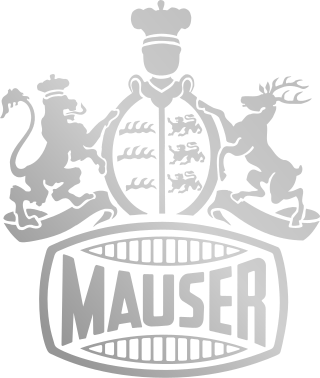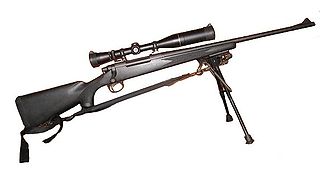Related Research Articles

In firearm designs, the term single-shot refers to guns that can hold only a single round of ammunition inside and thus must be reloaded manually after every shot. Compared to multi-shot repeating firearms ("repeaters"), single-shot designs have no moving parts other than the trigger, hammer/firing pin or frizzen, and therefore do not need a sizable receiver behind the barrel to accommodate a moving action, making them far less complex and more robust than revolvers or magazine/belt-fed firearms, but also with much slower rates of fire.

Bolt-action is a type of manual firearm action that is operated by directly manipulating the bolt via a bolt handle, which is most commonly placed on the right-hand side of the firearm.

In firearms terminology, an action is the functional mechanism of a breech-loading firearm that handles the ammunition cartridges, or the method by which that mechanism works. Actions are technically not present on muzzleloaders, as all those are single-shot firearms with a closed off breech with the powder and projectile manually loaded from the muzzle. Instead, the muzzleloader ignition mechanism is referred to as the lock.

Mauser, originally the Königlich Württembergische Gewehrfabrik, was a German arms manufacturer. Their line of bolt-action rifles and semi-automatic pistols was produced beginning in the 1870s for the German armed forces. In the late 19th and early 20th centuries, Mauser designs were also exported and licensed to many countries, which adopted them as military and civilian sporting firearms. The Gewehr 98 in particular was widely adopted and copied, and it is the foundation of many of today's sporting bolt-action rifles.

The M1903 Springfield, officially the United States Rifle, Caliber .30-06, Model 1903, is an American five-round magazine-fed, bolt-action service repeating rifle, used primarily during the first half of the 20th century.

The Remington Model 700 is a series of bolt-action centerfire rifles manufactured by Remington Arms since 1962. It is a development of the Remington 721 and 722 series of rifles, which were introduced in 1948. The M24 and M40 military sniper rifles, used by the US Army and Marine Corps, respectively, are both based on the Model 700 design.
The Winchester Model 70 is a bolt-action sporting rifle. It has an iconic place in American sporting culture and has been held in high regard by shooters since it was introduced in 1936, earning the moniker "The Rifleman's Rifle". The action has some design similarities to Mauser designs and it is a development of the earlier Winchester Model 54, itself being based on a Mauser 98–type action.

The Gewehr 98 is a bolt-action rifle made by Mauser for the German Empire as its service rifle from 1898 to 1935.

The M1917 Enfield, the "American Enfield", formally named "United States Rifle, cal .30, Model of 1917" is an American modification and production of the .303-inch Pattern 1914 Enfield (P14) rifle, which was developed and manufactured during the period 1917–1918. Numerically, it was the main rifle used by the American Expeditionary Forces in Europe during World War I. The Danish Sirius Dog Sled Patrol on Greenland still use the M1917, which performs reliably in Arctic conditions, as their service weapon.
The Pattern 1913 Enfield (P'13) was an experimental rifle developed by the Royal Small Arms Factory for the British Army as a result of its combat experience in the Second Boer War from 1899 to 1902. The weapon was to serve as a replacement for the Short Magazine Lee–Enfield (SMLE). An advanced chamber design allowed for a high-velocity .276 Enfield rimless round, which was more powerful than the service-issued .303 British cartridge. Introduction of the P'13 was rendered impractical by the outbreak of the First World War.

The Rifle, .303 Pattern 1914 was a British service rifle of the First World War period, principally manufactured under contract by companies in the United States. It was a bolt-action weapon with an integral 5-round magazine. It served as a sniper rifle and as second-line and reserve issue, until declared obsolete in 1947. The Pattern 1914 Enfield was the successor to the Pattern 1913 Enfield experimental rifle and the predecessor of the U.S. Rifle M1917 Enfield.

The origins of the modern British military rifle are within its predecessor the Brown Bess musket. While a musket was largely inaccurate over 100 yards (91 m), due to a lack of rifling and a generous tolerance to allow for muzzle-loading, it was cheap to produce and could be loaded quickly. The use of volley or mass firing by troops meant that the rate of fire took precedence over accuracy.

"Swedish Mausers" are a family of bolt-action rifles based on an improved variant of Mauser's earlier Model 1893, but using the 6.5×55mm Swedish cartridge, and incorporating unique design elements as requested by Sweden. These are the m/94 carbine, m/96 long rifle, m/38 short rifle and m/41 sniper rifle. Production began in 1898 at Carl Gustafs stads Gevärsfaktori in Eskilstuna, Sweden.
The Winchester Model 52 was a bolt-action .22-caliber target rifle introduced by the Winchester Repeating Arms Company in 1920. For many years it was the premier smallbore match rifle in the United States, if not the world. Known as the "King of the .22s," the Model 52 Sporter was ranked by Field & Stream as one of "the 50 best guns ever made" and described by Winchester historian Herbert Houze as "perfection in design." However, by the 1970s the World War I-era design was showing its age and had given way in top-level competition to newer match rifles from Walther and Anschütz; the costly-to-produce Model 52, which had long been a loss leader prestige product by that time, was finally discontinued when US Repeating Arms took over the manufacture of Winchester rifles from Olin Corporation in 1980.
The CZ-550 is a bolt-action hunting rifle series manufactured by Česká zbrojovka Uherský Brod. The CZ 550 series is available with a medium or magnum sized action. The CZ 550 rifle is based on the Mauser 98 rifle.
The Mauser M 98 are a series of currently (2020) produced bolt-action hunting rifles. The production of the controlled round feed Mauser 98 bolt action system for the German military ceased at the end of World War II in 1945. The new Mauser M 98 and M 98 Magnum rifles for civil users are in production since 1999 in Isny im Allgäu, Germany by Mauser Jagdwaffen GmbH, according to original drawings of 1936 and the respective Mauser patents. Mauser Jagdwaffen GmbH is a subsidiary of SIG Sauer.
The Mauser Model 1893 is a bolt-action rifle commonly referred to as the Spanish Mauser, though the model was adopted by other countries in other calibers, most notably the Ottoman Empire. The M1893 was based on the experimental M1892 rifle, which Paul Mauser developed for the Spanish Army as part of a program to correct deficiencies in the earlier 1889, 1890, and 1891 series of Mauser rifles. The M1893 introduced a short staggered-column box magazine that fit flush with the bottom of the stock; the magazine held five smokeless 7×57mm Mauser rounds, which could be reloaded quickly by pushing a stripper clip from the top of the open bolt.

The Blaser R8 is a German straight-pull rifle known for its radially locking bolt system, modularity and its barrel mounted scope mount manufactured by Blaser. The rifle also features a manual cocking system and a direct trigger. In 2015 there had been produced more than 100,000 complete Blaser R8 rifles.
The Model 721 and Model 722 along with the later Model 725 variant are bolt-action sporting rifles manufactured by Remington Arms from 1948 until 1961. The 721/722 replaced the short-lived Model 720. The Model 721/722 is considered to be one of the first modern, economically produced sporting rifles whose design largely continued with the subsequent and highly successful Model 700. Manufactured with high precision, it is known for exceptional accuracy. The bolt and receiver design, based on the Mauser action, is considered one of the strongest ever produced. Samples in excellent condition have become collectible.

A cadet rifle is a rifle used by military cadets and others for basic firearms and marksmanship training. Generally .22 caliber and bolt-action, they also come in semi-automatic versions. They are often miniature .22 caliber versions of standard issue service rifles.
References
- 1 2 3 4 "Model 30 Bolt Action". Remington Arms. Archived from the original on 16 October 2012. Retrieved 24 December 2012.
- 1 2 3 4 "Model 30 Express Bolt Action". Remington Arms. Archived from the original on 22 August 2012. Retrieved 24 December 2012.
- ↑ "Model 720 Bolt Action Centerfire Rifle". Archived from the original on 23 February 2014. Retrieved 12 February 2014.
- 1 2 3 4 5 Bolt Action Rifles - By Frank de Haas - ISBN 0-87349-168-8
- 1 2 3 Blue Book Of Gun Values - F.P. Fjestad - ISBN 978-1-886768-67-3
- ↑ p152 Bolt Action Rifles Frank de Haas, DBI Books Ltd, Northfield Illinois, 1971 ISBN 0-695-80220-8
- ↑ p153 Bolt Action Rifles Frank de Haas DBI Books, Northfield IL, USA, 1971
- ↑ p154 Bolt Action Rifles Frank de Haas DBI Books, Northfield IL, USA, 1971
- ↑ "Remington Model 30 Production
- ↑ "Remington Model 30 Express Production"
- ↑ Vanderpool, Bill "Bring Enough Gun" American Rifleman October 2013 pp.80-85&115-116
- ↑ "The military rifle cartridges of Honduras from Cortez to zelaya. - Free Online Library". www.thefreelibrary.com. Retrieved 14 December 2022.